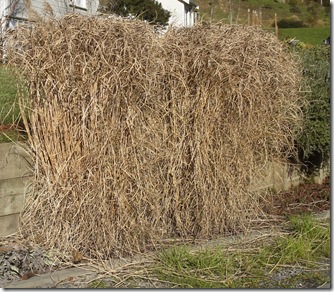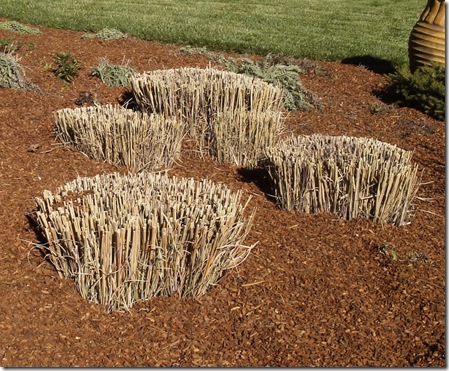Now’s the time for us mild-winter gardeners to prune back many of our ornamental grasses. But how do you know which to prune back all the way, which to deadhead, and which to leave be?
Well, if your grass is an evergreen and is still looking great, then leave it be unless you want to clean it up a bit. But if it’s gone brown and dormant, it’s time to trim.

I probably don’t need to say this as it is winter, but pull on some long sleeves and long pants, and wear gloves – Miscanthus blades in particular can give you a stinging cut, and I’ve gotten rashes from getting pricked up by them while pruning.
Now, for your little dormant grasses, like Japanese forest grass, simply take your handheld hedging shears (I love these Fiskars Power Gear Hedging Shears (click to see my video review); the gear makes them cut through things like butter) and prune every stem down to 2” tall. They’ll be back soon!
For your monster ginormous intimidating grasses (Miscanthus), you can prune one of two ways:
Either cut the whole thing back to 6-10” tall using your handheld hedging shears, starting from the very outside and cutting thin sections of grass at a time until you are done.
Or, bundle up the grass with twine so it stays together in a column of foliage, enlist a friend to hold it up (for goodness’ sake don’t trim their ankles!), and use your gas or electric hedging shears to cut the whole thing to 6-10”.

Then rake up the mess and if you like, plan to apply a bit of mulch after, which covers up the inevitable grass bits which won’t rake up nicely.

So, which ones to whack?
 Hakonechloa macra ‘Aureola’ or Japanese forest grass can be cut back to 2” tall once they go fully brown, which happens pretty early (November-ish).
Hakonechloa macra ‘Aureola’ or Japanese forest grass can be cut back to 2” tall once they go fully brown, which happens pretty early (November-ish).
Imperata cylindrica ‘Rubra’ or Japanese blood grass can get cut as soon as it goes fully brown, too. I take it to 2”.
Miscanthus or Maiden Grass gets cut down as soon as it stops being ornamental in its brownness and starts being messy. You’ll know when it is time to prune, because a bunch of the foot-long leaves will drop off the plant and scatter around the base, tangling in your other plants, on your lawn, etc. Take it back to 6-10”.
Calamagrostis x acutiflora ‘Karl Foerster’ or feather reed grass gets cut to 6” in January.
Which to prune differently:
Stipa gigantea or giant pheasant’s tail grass just needs its dead flower stalks removed in winter. You’ll see some new ones starting soon!
 Anemanthele lessoniana/ Stipa arundinacea or New Zealand wind grass doesn’t respond well to hard pruning, so if there are dead sections or you need to reduce its size, just grab a handful of foliage and prune it out at the base of the plant. Move around the plant, taking a small clump of grass from here and a small clump from there until you’ve removed a lot of the dead bits or cut away some of the longest-growing sections.
Anemanthele lessoniana/ Stipa arundinacea or New Zealand wind grass doesn’t respond well to hard pruning, so if there are dead sections or you need to reduce its size, just grab a handful of foliage and prune it out at the base of the plant. Move around the plant, taking a small clump of grass from here and a small clump from there until you’ve removed a lot of the dead bits or cut away some of the longest-growing sections.
 Nassella tenuissima/ Stipa tenuissima or Mexican feather grass usually gets pruned once yearly in September when they go kind of beige and dreadlock-y, and they come back gorgeously and make a fresh green winter accent for me. Cut the entire thing to 3”.
Nassella tenuissima/ Stipa tenuissima or Mexican feather grass usually gets pruned once yearly in September when they go kind of beige and dreadlock-y, and they come back gorgeously and make a fresh green winter accent for me. Cut the entire thing to 3”.
(Check out this article from The Germinatrix with her take on pruning this Stipa!)
 Phormium or flax just need to have any damaged or old foliage pruned out at the base. Many varieties have the best color on their newest leaves, so choosing the longest, widest blades (the oldest ones – they often have split tips) and cutting them out can make room for fresh new foliage.
Phormium or flax just need to have any damaged or old foliage pruned out at the base. Many varieties have the best color on their newest leaves, so choosing the longest, widest blades (the oldest ones – they often have split tips) and cutting them out can make room for fresh new foliage.
Want to reduce their size? Go around the plant gripping the tallest blades and pruning them out individually until the plant is at a better size. Never whack it to the ground unless you really must – they’ll come back, but with cut leaf tips that look awful.
Need to clean out the dead foliage?
This trick doesn’t work for all grasses, but when it does it is ace. Put on some gloves with a rubbery coating, like the ones on this page, and run your gloved fingers from the base of the grass to the top. You’ll be surprised at how much you pull out of your grass. This trick works particularly well with blue oat grass or Helictotrichon sempervirens.
Want to indulge in some over-the-top grass love?
What, you aren’t tired of thinking about grasses yet? Me neither! If you love grasses, my very favorite book on the topic is Nancy Ondra’s, called Grasses:
She breaks down the grasses into lists, so if you want one with variegated foliage or one that will do well in shade, you just turn to that page and there you are – photos and descriptions of grasses with that attribute.
And the photos are delectable; this is one of the few texts that I refer back to often just for the gorgeous photos of grasses used in the garden.
I also own Timber Press’ Color Encyclopedia of Ornamental Grasses by Rick Darke , but I find that I only reach for that one when I have a question about a specific grass (it’s a bit stiff), while the Ondra one is good for general information and gushing-over-how-cute-they-are awesomeness.
Does anyone have the latest grass books by Darke? Perhaps they are more fun than my 1999 version!
The Encyclopedia of Grasses for Livable Landscapes
Pocket Guide to Ornamental Grasses (Timber Press Pocket Guides)
Do you have any grass-pruning tips to share, book recommendations, or favorite grasses that you couldn’t do without? Be sure and leave your thoughts in the comments!
Resources:
Pick up those Fiskars Powergear Hedging Shears in my gardening store, or watch my video review of them here.
Learn how to prune other types of plant like a professional!

40 responses to “Ornamental Grasses: How to Prune Miscanthus, Stipa, and More”
Great post. I do like you suggest—–when I cut my grasses back, I first tie a big rope around the top or in sections if it’s a really big clump. Then you pick up the clumps and we throw them in the back of our truck. They get hauled down to the city compost.
Anna/Flowergardengirl’s last blog post..Planting Time At The Nurseries
hi I have this plant but I have a problemI have little white things at bottom of plant what to do any thing will help
Hi Genevieve, wonderful information here on many grasses. I would add the muhly grass, Muhlenbergia capillaris, cut it back in January also. The tip about the blue oat grass, I was hoping you would include that one, it it like detangling hair. I like to use both hands and really give it combing, good stuff for the compost and the grass looks so neat a BLUE!
Frances at Fairegarden
Frances’s last blog post..Bloom Day January 2009-Few But Faire
I was just wondering about how to prune some grasses I planted at my parents’ house. I cut off the dead tips, but didn’t cut them all the way down since they weren’t already dead. It sounds like I should have waited for the grass to die all the way down?
Fern’s last blog post..My Favorites From Garden Bloggers Bloom Day
Anna, I love the vision I have in my head of you flinging those big stacks of grass into the back of the truck! Yay for us strong gals!!!
Frances, thanks for the great advice about Muhly Grass. We don’t actually grow it very well here because of our wet weather, so I’m glad to know how to treat it in case I come across a rogue patch that is happy (and in well-draining soil!).
Fern, it’s hard to say for sure without knowing the variety, but once you cut the tips off the rest will usually die down, so I’d probably just cut them back entirely and then perhaps give them a half dose of organic fertilizer since you are in a nice warm climate, right? But gosh, I’d hate to tell you wrong and I may be, not knowing which grass it is.
Does it have big floofs for flowers? In summer, is it green, orange, purple? How big does it get? (I’m trying to be a plant detective here).
One of the common pretty ones I didn’t mention is Pennisetum, which grows well in your climate, I think! Those are safe to cut if it isn’t freezing where you are at, even if they haven’t died down entirely. (It varies widely if they are safe to cut elsewhere – some species are tender and so shouldn’t be cut yet, others are hardy and fine.)
We just don’t have enough ornamental grasses in our garden and this post has given us the needed incentive to go for it. I linked to this post under my discussion of Phormiums. Once again, thx for the best info!!
Thank you so much for your kind words and the link, Iona! I’m honored to be included in your excellent discussion of Phormiums.
Oh, I am late with my miscanthus this year! It’s such a pain, and I have two actually, that I always put it off too long. Tip for pruning back dead foliage on pampas grass – wear full Kevlar body armor! OK, at least long sleeves and gloves that fully cover your wrists. And maybe protective glasses too. Eek! Great post!
.-= Karen´s last blog ..SAGBUTT Saturday – February 27 at CUH =-.
Hi i am a big fan of grasses started using them 2 years ago when one of my customers wanted a garden planted with them , my problem is i planted five newzealand wind grasses they were beautiful but have become brown and dry at the tips .Can i trim these off or do they need feeding thanks Mandy
That happens sometimes Mandy. They respond just OK to pruning back hard. If the whole plant looks bad, do it, but feed them and be willing to replace the plant if need be.
I usually just grab small sections of the grass, and prune out small bundles at a time – removing about 1/6 of the plant every two-three months till they fill in with lots of fresh new growth. At the same time, make sure it is getting adequate water and fertilizer, preferably slow-release organic, to stimulate fresh new growth.
Hope that’s helpful.
[…] on, or things that aren’t too heavy to lift, like autumn leaves or the mass of leaves from pruning Miscanthus grass. Be sure and set your branches going all in one direction so the tarp’s easy to lift and carry. […]
I have a huge bush of stripey stemmed asparagus-like grass.I need to reduce it but how?
Diana – not sure what plant you are talking about! Email me a photo and if I can, I will help.
I didnt prune my Japanese Forest Grass… should i do it now or just leave it alone?
Do it now, but don’t cut off any new growth that may be emerging!
Hi-
I’m looking for someone to come speak about ornamental grasses to a group of gardeners in Gresham. Its a volunteer club, but we feed our guests! Genevieve, would you be interested? Please email if you are, or know someone else that might be interested. Thanks!
Hi Rita, I’m sorry, but no, I already volunteer about five days a month and can’t take on any more volunteer work. Perhaps you might like to look on Great Garden Speakers (.com) and see if there are any people willing to speak for free that live in the area? Or maybe you could rally the troops and pay a local speaker a nominal fee? Or partner with a local nursery to have them hold a speech and you guys could buy plants afterwards? Just brainstorming for you. Good luck.
I ran across this blog and was excited to see detailed instructions on ornamental grass clean up!! My husband and I just purchased a historic herb farm in Ky and have discovered we have 2 acres of lush beautiful ornamental grass! I have been able to identify most all of the types we have (at least 12 types) and I am interested in learning how to market these plants. The prior owner actually shipped starts 5 days a week all over the country in spring and summer! We also have 2 acres of bamboo and need to find out how to best market it as well! I have been a gardener for many many years, and I will admit that restoring this historic farm is going to take it’s toll but the rewards are far going to outweigh the work!! Do you have and ideas on how to best market my existing ornamental grass and bamboo? I am in the process of developing a website now, Briar Ridge Herb Farm………………….thanks so much for any input!!!
Hi Pam, congrats on your new business! I’m excited for you. When you’re ready to hire a firm to help you with your marketing, I’d highly recommend Jean Ann Van Krevelen from White Willow Media: http://www.whitewillowmedia.com . She does a marvelous job and is skilled with working with companies in the green industry. She may offer consulting.
Hi again, Genevieve! I was googling about how and when to cut back Stipa gigantea and up popped this post. I love when that happens. Anyway, this Stipa is not found around my area in TN at all. I grew a patch from seeds, it did well and flowered last year. It was larger than I had expected so last fall it was dug up and divided and replanted elsewhere. The old foliage is laying flat on the ground and is unattractive. Can I safely cut it back, cut everything to about 6 inches or leave it alone and let the new growth cover up the ugly? Thanks for still taking comments on old posts!
xo
F
Hi Frances,
I’m delighted to hear from you! Yes, you can safely cut back Stipa gigantea’s foliage to 6″ whenever needed. I usually do that every other year instead of every year since I hate to prune things hard if they don’t seem to need it, but in my climate they have always come back gracefully from a strong pruning and looked much improved for it. Warm wishes to you,
Gen
Thanks!
ok due to our unusually warm winter the grasses in my front yard have thrown up new shoots sooner than I was ready. They are a variety (2 are Miscanthus, I can’t remember the rest). I usually cut them down to about 6″ or slightly higher, and then give them a little food. But I don’t know if I should still do it since the new growth is already well past that mark. any ideas?
thanks in advance!
Hi! I planted mexican feather grass down both sides of my drive way (San Diego)…I love it! I came home to see it has all been cut down to the ground! It was golden brown..but still beautiful with motion. I am horrified…I miss it..will it grow back fast or do I need to replant? I am not sure if the gardeners did me a favor, or destroyed my beautiful ocean of grass….was cutting it back the correct thing to do?
Thanks!
They did you a favor – great time to prune, and they did it just right. It will be back shortly for some winter interest! 🙂
Oh no! My gardener’s assistant just whacked 4 of my big phormiums down to 12″. I’ve lost all that architecture. While my gardener has offered to replace them, I’m thinking I should have him leave them in place and interplant with something temporary. Maybe big euphorbias.
Any advice?
Not to worry, Tomik, and no need to interplant. They’ll be back shortly. I sometimes whack them if they have gotten too far overgrown to do anything with, and they return in a matter of 4 months. As they regrow, just remove the leaves with cut tips so it will look more graceful as it comes back. But it will come back. By the time anything else fills in, the Phormiums will have long ago taken up the spot again.
Many thanks! We all feel much better after your reply.
Hello Genevieve – I have some mature miscanthus that I cut back every spring without any problems. This year I may have done something wrong — either the timing or length of cut — but as the new growth is emerging, it has four or five inches of brown, dry tips. Should I be trimming these tips back to the green? I don’t want to cause further damage! Thanks so much for any guidance.
Our miscanthus giganteus forms a beautiful hedge providing privacy in the summer. However, we had a very windy day and some of the grasses are now lying on the ground. Should we trim them now? Or leave them be?
You could always stake them up using some garden stakes and landscaping ties? They won’t come back very well if you prune now.
I have found little consensus online or in garden stores on when and occasionally whether to cut back Mexican Feather Grass. I love this plant and have a lot of it in the front of my house. The prior owners cut it back late winter before new growth started but I have had others tell me it should be cut back in summer (I had a landscaper do this when she thought it looked “floppy” and it looked so poor for so long afterwards that I ended up replacing a number of the plants.) You mention a fall cutback and I haven’t tried this because I think it looks beautiful in the fall. Would it grow back quickly in NC? Can it not be cut back at all and simply “thinned” with a rake?
Well, the only reason you’d cut it back is if it looks terrible – clumpy and dreadlocky – I don’t bother with it every year. So yes, if thinning with a rake (I’d actually use your hands, covered in a pair of rubber gloves, before I’d risk smashing them down with a rake) gets the look you need, go for it! There is no horticultural reason to cut them to the ground before they obviously need it and have gone clumpy.
Once you do need to prune, timing is a matter of personal preference as much as anything else. If you cut back in summer or early fall, it’s back for you to give winter interest. If you prune in early spring, you can enjoy it all year but miss the spring foliage, which is nice as it’s one of the few grasses around then.
If it takes a long time to come back, I would suspect a possible care issue. Plants that are cut back sternly do need some water and fertilizer to help them regrow quickly and healthfully. While they can normally tolerate little or no water, if you cut them back at the height of the dry season and don’t give them supplemental water and fertilizer (pref organic), it will take some time before they are able to suck enough water from the ground to come back.
That said – hard to diagnose when I am not there seeing the plant!
I hope all that helps you out and gives some food for thought. 🙂 -Gen
We’re planting Japanese Blood Grass, 1) Is it to late in the season and after it dies out this fall/winter will it grow back.
[…] written before about how to prune ornamental grasses – which ones you ought to whack and how, and which you ought to leave be. The Miscanthus grasses […]
[…] that hard. Anticipate that your plants will grow and cut out a bigger hole. This goes doubly for ornamental grasses like Miscanthus, which flop unattractively and become impossible to dig and divide when a 3′ […]
[…] go dormant in winter, it takes almost no time to use a pair of handheld hedging shears and cut them down to a couple inches from the […]
what is the best way to trim Facahatchee grass?
I have never heard of that grass! Sorry I cannot be of help.
Help. I purchased Muhly Grass and had the sod company plant 7 each here in north central Florida. 6 look great (upright & healthy green). One has some yellow in the capillary branches, is dense, long and laying flat for the most part. The seller has not responded to my concerns. Do I need this plant replaced ? Should I trim it. again help.